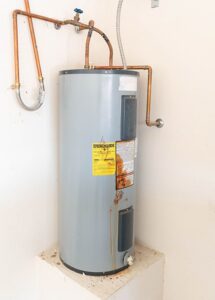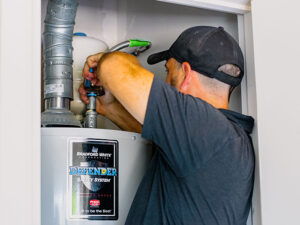Tankless Water Heater Atlanta don’t use a tank and heat only when hot water is needed. When the flow sensor detects demand, the unit ignites, and a gas burner or electric heating element heats water in pipes.
Homeowners with these units enjoy energy efficiency that’s 24 to 34 percent better than tank storage models. They also reduce utility costs over the lifetime of the unit.

The tankless variety heats water on demand, reducing energy consumption by heating only when needed. This reduces the gas or electricity used to heat your hot water, lowering utility bills. It also means you aren’t wasting fossil fuels at power plants, reducing greenhouse gases and other pollutants that contribute to climate change.
Depending on the size of your home, a gas tankless water heater can save up to 50 percent in energy costs compared with a traditional water heater with a storage tank. This makes them a great investment for homeowners looking to save on their energy costs.
Switching to a tankless water heater will likely increase your upfront installation costs. This is because tankless systems often require installing new gas and venting lines. However, the additional costs can be offset over time when you start saving on your energy bills.
The energy efficiency of a tankless water heater can be measured by its temperature rise rating and the gallons per minute (GPM) it can supply. The lower the temperature rise and higher the GPM, the more efficient the unit is.
When selecting a tankless system, look for a model rated by an independent testing agency for performance and safety. This will ensure the unit is certified to operate correctly and won’t be prone to malfunctions.
Also, a tankless unit with a built-in water temperature sensor and a remote digital control is a good energy-saving option. This will help prevent the water from running too hot, which can damage pipes and fixtures.
Another way to make a tankless system more energy efficient is to install a recirculation loop, which will speed up the time it takes for hot water to reach the fixture. The best way to do this is with a Navien-certified professional who can design and install a complete system.
The last con that should be considered is the fact that a tankless system can still experience mineral buildup in the pipes. However, this problem can be prevented by having a professional plumber service your tankless system annually, including cleaning or changing the air and water filters, flushing the burner, and checking for mineral buildup in the heat exchanger. This can also help extend the lifespan of your unit.
Tankless water heaters are compact, so they don’t take up any more space than the average house appliance. If your home has a limited amount of storage space, then a tankless heater is a great choice for you. A conventional water heater can take up much of your utility closet, basement, or garage. This can make it difficult to use those rooms for other purposes or even to store other household items. But a tankless water heater is very small and can be mounted on the wall, freeing up all that valuable space.
Another reason to invest in a tankless water heater is the energy savings. A traditional tank water heater has a limited supply of hot water that must be constantly heated to keep it ready for use. A tankless water heater only heats your water when you need it, so that requires much less energy.
Many energy companies offer rebates and incentives to encourage people to upgrade their appliances to more efficient ones like tankless water heaters. If you take advantage of these offers, then the system can pay for itself in a very short period. You can also pair your tankless water heater with solar panels, further increasing your energy efficiency and saving you money on fuel costs.
Lastly, tankless water heaters can last a very long time and are less likely to suffer from leaks or other damage as the years go by. This makes them a smart investment for your home.
If you’re interested in a tankless water heater for your home, speak with a professional plumber about the best models to suit your needs. You’ll want to consider things like water usage patterns, the environmental factors in your area, and your current piping and wiring configurations. A highly-rated plumbing or heating and AC contractor can help you choose the right model for your home and install it properly. They can also ensure you get a gas or electric model that meets your home’s safety and efficiency requirements and qualifies for any available rebates or incentives.
When a tankless water heater is properly sized and installed, it can provide an endless hot water supply. This means you and your family can shower, wash dishes, and run laundry simultaneously without running out of hot water.
However, it is important to note that a tankless water heater is still limited in how much hot water it can produce simultaneously. This limitation is based on the amount of gas or electricity it uses to heat the water, and it is also determined by how much hot water is demanded at one time. The water heater may shut off if too much hot water is required.
This can be a nuisance, but it is necessary to prevent the heater from overheating and causing damage to your plumbing system. This problem can be resolved by hiring a plumber with experience working on tankless water heaters. They can inspect your entire plumbing system, find the source of the situation, and fix it before it worsens.
If you have a gas tankless water heater, look for a model that has an intermittent ignition device (IID). This electronic spark control reduces the amount of gas used by your unit. It works in the same way that a spark ignition device does on natural gas furnaces, kitchen ranges, and ovens.
An electrical tankless water heater can be equipped with a recirculation pump, which can be turned on by a button or sensor located within the home, a smart device app, or a digital controller. When the system is activated, a water-recirculating pump pushes cold water in your pipes back through the water heater. This process quickly warms the water and brings it to your fixtures.
This can help eliminate cold water splashing or scalding when you turn on a hot faucet, and it can also save energy by eliminating standby heating losses. This is especially useful in homes that use a lot of energy-efficient appliances.
A tankless water heater does require regular maintenance to keep it running smoothly. These systems don’t have a tank that can rust, but they have a burner, heat exchanger, and other components subject to the same maintenance issues as a traditional water heater.
One issue is mineral buildup on the heating elements. When these elements have a layer of buildup on them, they cannot efficiently transfer heat to the water and will likely fail sooner than they should. This common problem can be prevented with periodic flushing of the system.
A water heater professional will perform this flushing by temporarily turning off the power and draining the unit. They will then run a solution through the small chamber that will help remove any remaining minerals. Once the system has been completely flushed, they will turn on the cold water supply and hot water output valves and restore power to the unit.
Some natural gas tankless units also have a filter between the air intake and fan that may need to be cleaned. This usually involves removing the filter, rinsing it, cleaning it with vinegar, and re-inserting it into the unit.
Another common maintenance task is ensuring that the temperature setting on the water heater matches the water temperature coming out of the taps. This helps prevent scalding and ensures that there is always enough hot water to meet your needs.
Tankless water heaters often have a pilot light that must be kept clean and properly adjusted to operate safely. This resembles the pilot lights on natural gas furnaces, kitchen ranges, and ovens. A plumbing professional will be able to maintain the pilot light and ensure that it is operating correctly.
Many homeowners choose to take the DIY route with tankless water heater maintenance. This can be a good option for those who are fairly handy and want to save on annual maintenance costs. However, you are still trying to figure out what to do or have any questions regarding your tankless water heater maintenance. In that case, it is recommended that you contact a professional plumber for your safety and peace of mind.

